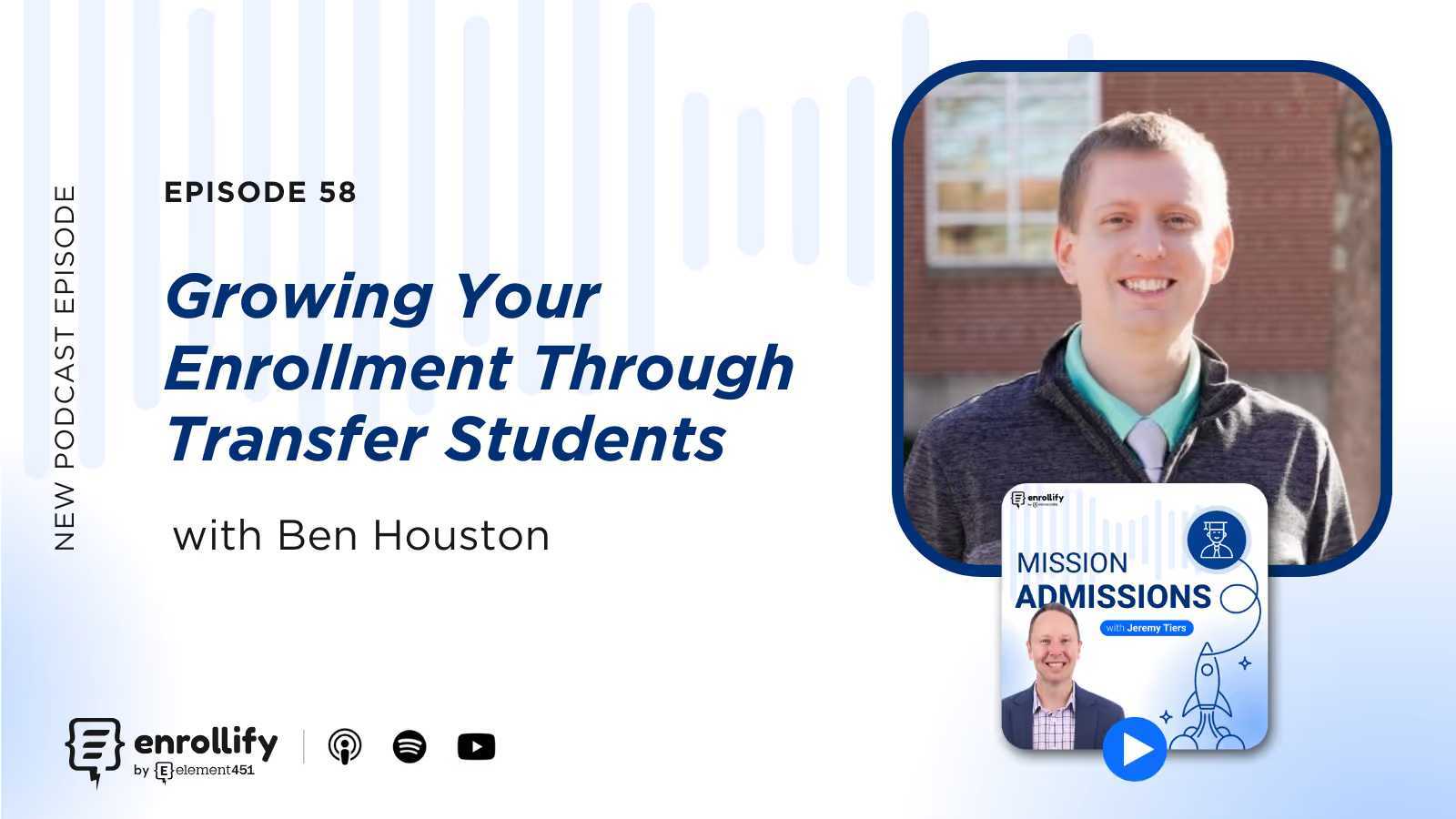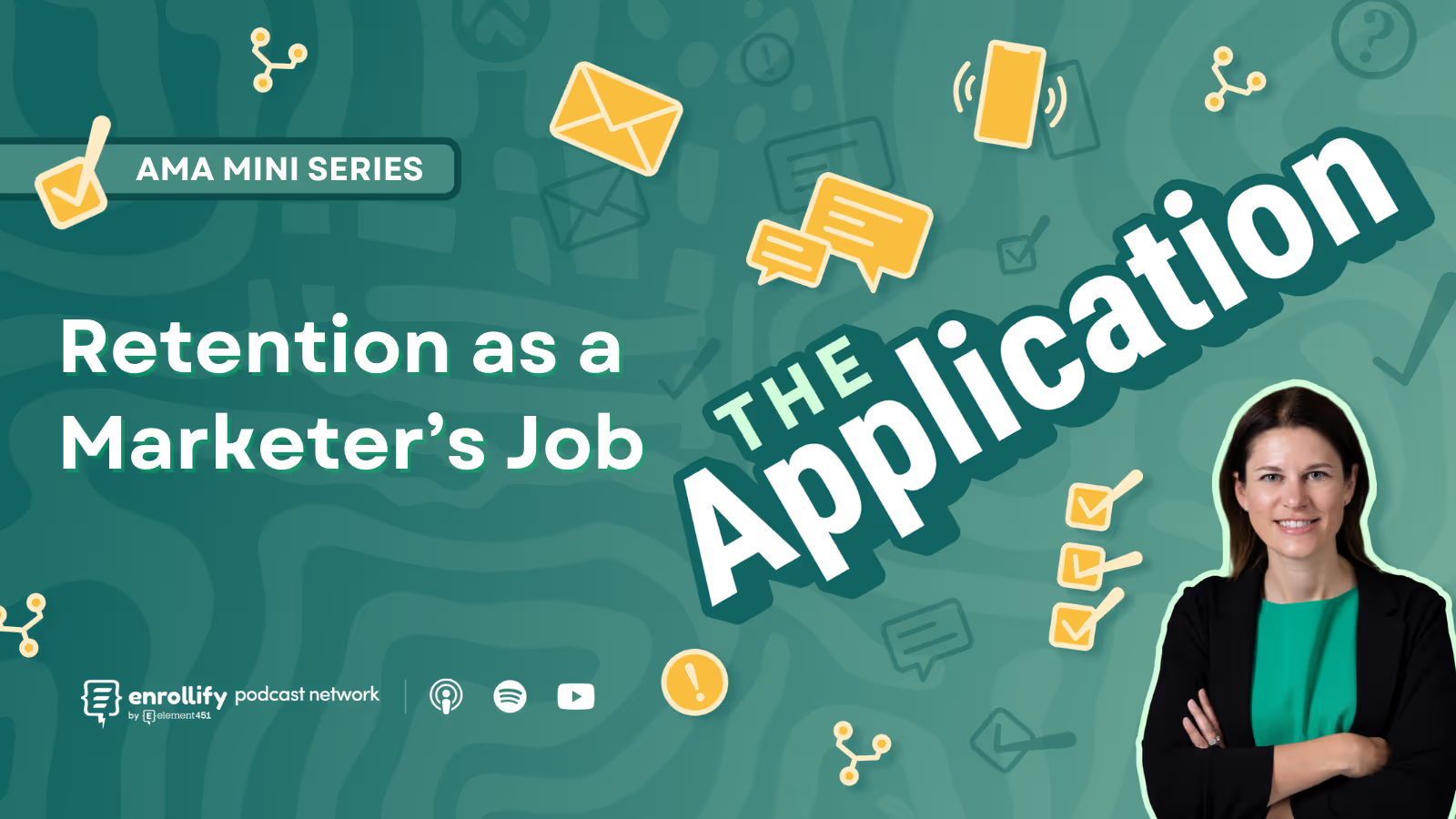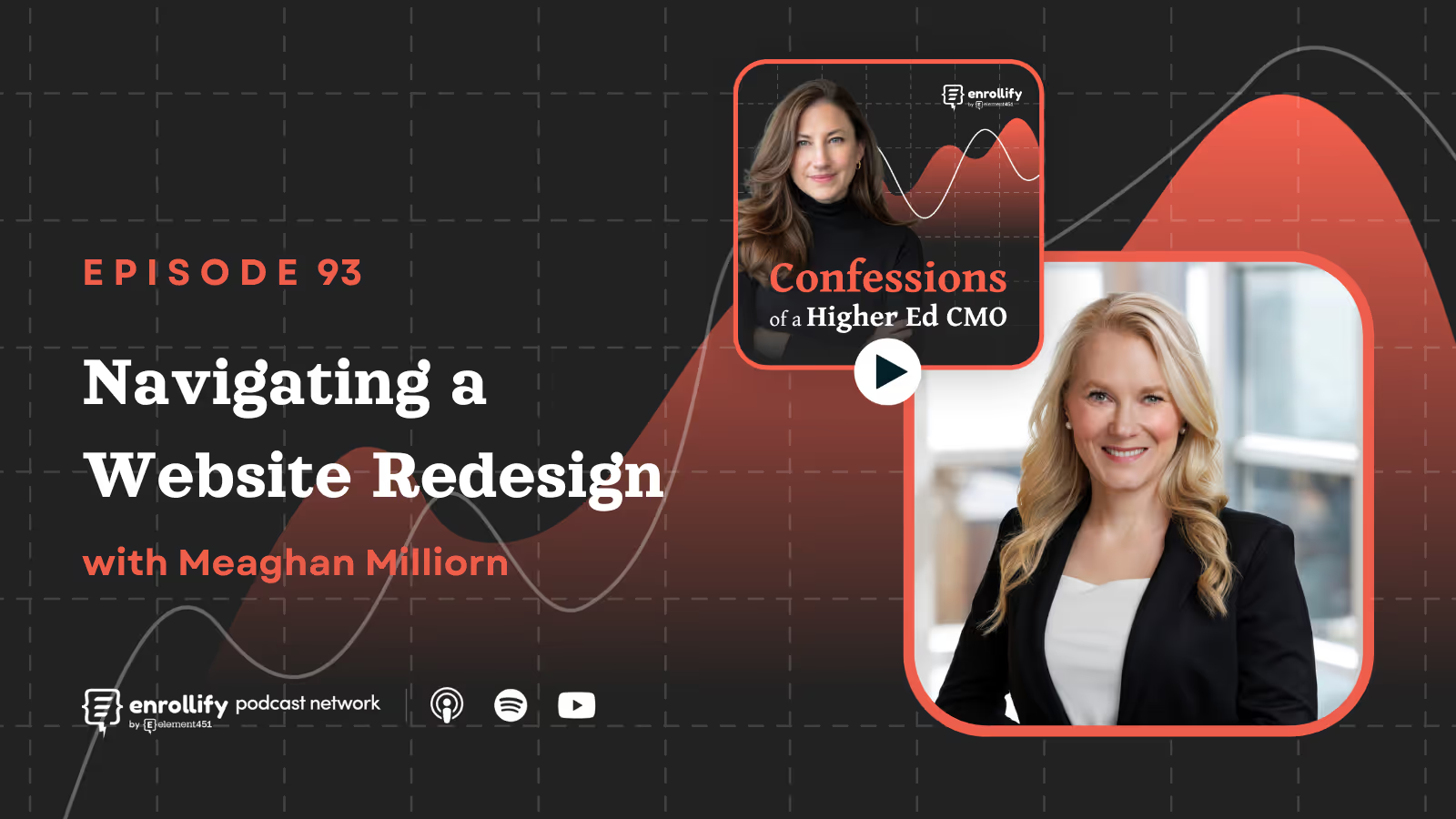About the Episode
Got a story to tell? An innovative idea to share? Fill out our guest nomination form and let's chat!
About the Episode:
In this episode Jeremy discusses the increasing trend of transfer enrollment with his guest Ben Houston. They explore the challenges and opportunities within this population, the importance of utilizing data, and the need for a supportive environment when transfer students start their journey on a new campus.
Key Takeaways
- Transfer enrollment is increasing – National data shows a 7.7% rise in transfer students, particularly from two-year to four-year institutions.
- Proactive recruitment is essential – Many colleges take a "wait and see" approach to transfer enrollment, but intentional outreach is necessary for sustained success.
- Data drives institutional change – Using national and institutional data helps build a case for increased resources and support for transfer students.
- Challenging stereotypes – The misconception that transfer students are less prepared for four-year institutions is false; in fact, they often have higher GPAs and persistence rates.
- Community college partnerships are key – Establishing articulation agreements and engaging advisors and faculty at two-year institutions leads to stronger transfer pipelines.
- Transfer-friendly policies matter – Evaluating and adjusting transfer credit policies can remove barriers and encourage more students to enroll.
- Authentic student storytelling resonates – Prospective transfers connect best with current students who have successfully navigated the transition.
- Support doesn’t stop at enrollment – Creating transfer-specific orientation programming and student engagement opportunities enhances retention and success.
Why Colleges Need a More Proactive Approach to Transfer Enrollment
Many institutions still treat transfer enrollment as an afterthought, assuming that students will seek them out without much proactive outreach. However, the latest data from the National Student Clearinghouse reveals that transfer enrollment is growing, especially among students moving from community colleges to four-year institutions. As traditional high school graduate numbers decline, universities must shift their strategies to intentionally recruit and support transfer students.Ben Houston emphasizes that a strong transfer strategy starts with institutional buy-in. Enrollment teams must showcase the value of transfer students—both in terms of enrollment numbers and diversity—to gain support from leadership. He recommends using national data and internal enrollment trends to highlight opportunities and secure more resources for transfer recruitment and services.
How to Advocate for More Transfer-Friendly Resources on Campus
One of the biggest challenges in transfer admissions is convincing leadership to invest more in this population. Many transfer admissions counselors feel like an afterthought in their offices, as traditional first-time freshmen tend to receive the bulk of attention and resources.Ben suggests using data-driven advocacy to make a compelling case for investment in transfer enrollment. By demonstrating where transfer students come from, how they perform academically, and what barriers they face, counselors can push for changes that make their institutions more transfer-friendly. He also highlights that transfer students often contribute to diversity goals, as they tend to include a higher percentage of underrepresented minority students, working adults, and first-generation college-goers. Aligning transfer initiatives with institutional missions can help secure leadership support.
Debunking Stereotypes About Transfer Students
A persistent myth in higher education is that students who start at community colleges are less prepared for four-year institutions. Ben pushes back against this assumption, citing national data that shows transfer students often outperform their first-time freshman peers in GPA and persistence rates—especially when they receive adequate support.To overcome misconceptions, institutions need to:
- Educate faculty, staff, and leadership on the strengths of transfer students.
- Ensure transfer students have access to resources like academic advising, financial aid support, and career services.
- Improve credit transfer policies to minimize the loss of previously earned credits.
Building Stronger Community College Partnerships
A major component of UIndy's transfer success has been intentional partnerships with local community colleges. Ben explains that one of his first steps in strengthening transfer pathways was identifying where the majority of their transfer students were already coming from. By deepening engagement with those institutions—through articulation agreements, faculty partnerships, and in-person visits—UIndy was able to attract more transfers from those schools.However, simply having agreements in place isn’t enough. The key to success is ensuring that advisors and faculty at community colleges actively promote the pathway to prospective transfers. UIndy accomplished this by:
- Conducting regular visits to community colleges for advising sessions.
- Engaging current transfer students as ambassadors to share their experiences.
- Hosting virtual and in-person transfer information events to answer questions in real-time.
Balancing Virtual and In-Person Transfer Recruitment
When it comes to recruitment, finding the right mix of digital engagement and in-person outreach is crucial. Ben shares that at UIndy, they prioritize face-to-face visits at community colleges where they already have strong enrollment pipelines. Meanwhile, they use virtual outreach—such as online advising sessions and webinars—for schools in regions where in-person visits are less practical.A good rule of thumb for institutions trying to optimize their efforts is to analyze past enrollment trends and invest more resources where they are already seeing success. This allows for a data-informed recruitment strategy that maximizes time and budget.Communicating with Prospective Transfers EffectivelyUnlike first-time freshmen, transfer students are often balancing work, family, and other responsibilities, which means their communication preferences may differ. Ben emphasizes that:
- Transfer students are ROI-driven, so messaging should focus on career outcomes, time to degree, and affordability.
- Peer storytelling is more effective than traditional marketing—he regularly recruits successful transfer students to share their experiences through panels and outreach.
- Personalized communication is key—UIndy's transfer team makes sure to connect via email, phone, and text messaging, depending on student preferences.
How to Ensure a Smooth Transition for Transfer Students
A truly transfer-friendly institution doesn’t just recruit students—it ensures their success after they enroll. At UIndy, one major improvement has been the introduction of transfer-specific orientation programming. Historically, transfer students were grouped into traditional first-year orientation events, but the university has since created exclusive welcome week activities tailored to their needs. UIndy also prioritizes:
- Providing dedicated academic and financial advising to ensure students have a clear path to graduation.
- Hosting transfer-specific networking events to help students build connections with peers who share similar experiences.
- Making career services accessible early on, since transfer students often have a shorter time frame before entering the workforce.
Final Thoughts
For institutions looking to increase transfer student enrollment and success, the key takeaways from this episode are clear:
- Be proactive, not reactive—Intentional recruitment and relationship-building are essential.
- Use data to advocate for resources—Show leadership why investing in transfer students aligns with institutional goals.
- Prioritize partnerships—Engage community colleges, advisors, and faculty in the recruitment process.
- Support transfers beyond enrollment—Retention strategies tailored to transfer students lead to better outcomes.
Connect With Our Host:
Jeremy Tiers
https://twitter.com/CoachTiers
Attend the 2025 Engage Summit!
The Engage Summit is the premier conference for forward-thinking leaders and practitioners dedicated to exploring the transformative power of AI in education.
Explore the strategies and tools to step into the next generation of student engagement, supercharged by AI. You'll leave ready to deliver the most personalized digital engagement experience every step of the way.
👉🏻 Register now to secure your spot in Charlotte, NC, on June 24-25, 2025! Early bird registration ends February 1st.















